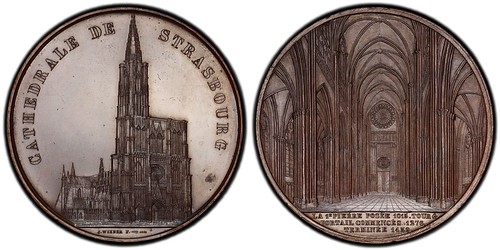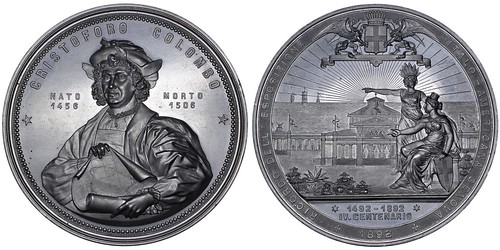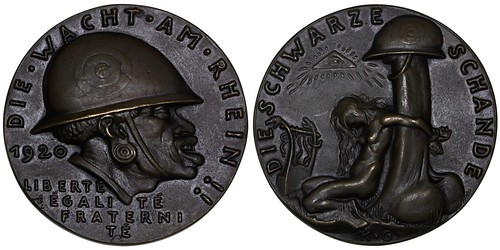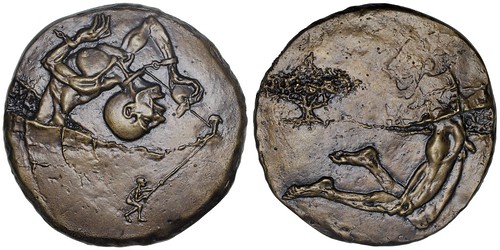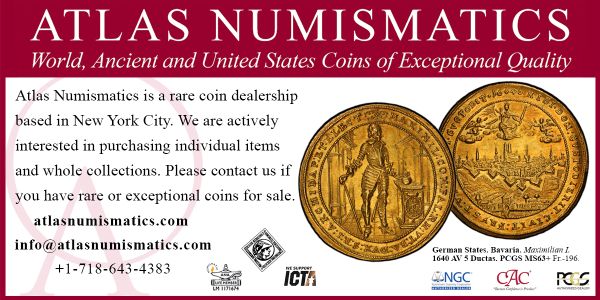
PREV ARTICLE
NEXT ARTICLE
FULL ISSUE
PREV FULL ISSUE
NUMISMAGRAM MEDAL SELECTIONS: APRIL 6, 2025Numismagram's Jeremy Bostwick sent along these five medals from his most recent upload of new material to his site. For all of the new items, please visit https://www.numismagram.com/inventory. -Garrett
102935 | FRANCE. Strasbourg Cathedral bronze Medal. Issued 1861. Most Remarkable Edifices of Europe series (59mm, 12h). By Jacques Wiener in Brussels and struck at the Geerts mint in Ixelles. CATHEDRALE DE STRASBOURG, perspective view of the cathedral exterior from the northwest, highlighting its ubiquitous single northern tower // Perspective view of the interior, looking down the nave toward the west from a vantage point just to the right of center; the western rose window is at the focal point; in three lines in exergue, LA 1e PIERRE POSÉE 1015 TOUR & / PORTAIL COMMENCÉS 1276 / TERMINÉE 1439. Ross M237 (R2); van Hoydonck 185; Reinecke 45. PCGS SP-63. Deep brown surfaces, with a bit of a glossy nature in the fields; a minor spot is noted in the lower right field, accounting for the designation. $545. Described by Victor Hugo as a "gigantic and delicate marvel," Strasbourg Cathedral in the Alsace region of France was begun near the start of the 11th century and completed in 1439. Though many aspects are built in the Romanesque style, it also features some of the best examples of the Rayonnant Gothic style. For over 200 years, from 1647 to 1874, it served as the world's tallest building at 466 feet. Now, it is the world's sixth tallest church, and still serves as the tallest extant church constructed in the middle ages. From what is today eastern Netherlands and western Germany, the Wieners were a Jewish family of exceptional medalists, especially known for numerous numismatic works throughout the Kingdom of Belgium. Eldest brother Jacob (Jacques), along with younger brothers Leopold and Charles, created some of the finest works of medallic art of the 19th century, and all are particularly noted for their work in the highly detailed and intricate work of architectural renderings.
To read the complete item description, see:
103114 | UNITED STATES, ITALY & GERMANY. Christopher Columbus/Italian-American Expo aluminum Souvenir Medal. Issued 1892 for the 400th anniversary of the discovery of America and for the expo held in Genova (90mm, 80.88 g, 12h). By Wilhelm Mayer in Stuttgart. CRISTOFORO COLOMBO / NATO 1456 - MORTO 1506, half-length bust of Columbus facing slightly left, holding charts; star to left and right // RICORDO DELL' ESPOSIZIONE ITALO–AMERICANA GENOVA, two female allegories (Italia and America) to right, one seated and one standing, pointing at a distance to left over the expo ground; Nina, Pinta, and Santa Maria on horizon to left with rising sun; above, crowned coat-of-arms of Italy with griffins as supporters; in two lines in exergue, 1492–1892 / IV. CENTENARIO. Edge: Plain. Eglit 582 (this piece illustrated); cf. Eglit 261 (for seemingly a duplicate entry of the type); Starlust ST-eg-582; cf. Starlust ST-eg-261 (same); Rulau B5A; cf. Bernd Kaiser V, 126 (bronze). Choice Mint State. Highly lustrous and brilliant. An exceptionally impressive specimen, especially given its advanced state of preservation and unrivaled pedigree, as it even served as the plated example in Eglit's self-published 1965 reference. Ex Nathan Eglit Collection (Presidential Coin & Antique 52, 27 June 1992), lot 269, where Joe Levine described it as "Unc, even gray color, near perfect" and a "massive 3 1/2 inch medallic beauty!" $1,695. During the lead-up to the quadricentennial of Columbus's initial contact with the New World, numerous medals were designed and struck, both in the United States—in conjunction with the 1893 Columbian Exposition in Chicago—and abroad, sometimes for this event or for similar others. In the case of this wondrous medal, the Italian-American Expo held in 1892 in Genova—the home of Columbus. This same general design would be used by Wilhelm Mayer the following year for related types associated with the World's Columbian Expo in Chicago. This item was featured in our E-Sylum ad.
To read the complete item description, see:
103019 | GERMANY & FRANCE. Black Shame/The Watch on the Rhine cast bronze Medal. Dated 1920. "Die schwarze Wacht am Rhein"—on the supposed sexual crimes against German women by Franco-African soldiers (58mm, 65.37 g, 12h). By Karl Goetz in München. DIE WACHT AM RHEIN!!, helmeted head of French-African soldier right, with heavily caricatured features such as the lower lip and stretched earlobe; in four lines to lower left, LIBERTÉ / ÉGALITÉ / FRATERNI / TÉ // DIE SCHWARZE SCHANDE, nude Lorelei (representing vulnerable German women in the Rhineland) with her arms behind her, chained to oversized male genitalia surmounted by helmet (representing supposed sexual crimes committed by Franco-African soldiers); broken lyre to left, with tops terminating in heads of eagles; radiant Eye of Providence above, with rays almost acting as tears. Edge: Plain. Kienast 262; Jones, Dance of Death, 52. Choice Mint State. Darker olive-brown surfaces, with a few light casting flaws near the edge. An extremely provocative and popular medal. $895. Following Germany's defeat in World War I, French and British troops occupied portions of Germany to ensure that reparations would be paid. In some areas, such as the Rhineland, France utilized colonial troops from North Africa for patrolling and occupying—possibly serving as an act of further humiliation—making the local Germans be subject to those who were, in turn, subject to a colonial power. Within Germany, however, sentiments became overtly racialized, with anti-African propaganda found everywhere in the print media, and with caricatures and stereotypes endlessly employed. This biased and unfounded campaign even found its way into numismatics, with many medals featuring iconography that reveals these feelings. At the forefront was the belief that African troops, racially portrayed as oversexed and primal, were ravaging German women. Though this campaign subsided in the early 1930's, it wasn't the first appearance of this form of racism, and certainly wouldn't be the last. Along with the "Sinking of the Lusitania" medal, this extremely provocative medal stands as one of the more iconic, controversial, popular, and rather infamous (all at the same time) of Goetz's entire oeuvre.
To read the complete item description, see:
102967 | GERMANY. Dr. Hugo Eckener silver Medal. Issued 1929. Commemorating the world tour of the LZ 127 Graf Zeppelin (36mm, 12h). By Karl Goetz at the München mint. Dr ECKENER WELT–FAHRT MIT "GRAF ZEPPELIN", bust left / TOKIO • LOS ANGELES • LAKEHVRST • FRIEDRICHSHAFEN, the earth surrounded by a zodiacal band and highlighted by onlookers to the east and west, and a polar bear to the north; the airship flies above, guided by an eagle. Edge: BAYER. HAUPTMÜNZAMT • FEINSILBER. Kienast 429; Hans Kaiser 497. PCGS SP-62 Matte. Light gray surfaces, with some hints of amber-cabernet toning around the devices. $395. Zeppelin was a German general and aircraft manufacturer, who later founded the airship company Luftschiffbau Zeppelin. Following Zeppelin's death in 1917, Dr. Hugo Eckener became the head of this company and oversaw post-war fundraising to expand upon its production, even serving as commander for the LZ 127 on numerous occasions. When this airship first entered use, it was the first commercial passenger transatlantic flight service in the world, eventually making 590 flights over nearly a decade. In 1940, she was scrapped for metal for the German efforts in World War II.
To read the complete item description, see:
103146 | GREAT BRITAIN. "The Fruit of Knowledge" cast bronze Medal. Issued 1989 (62mm, 110.01 g, 12h). By Gordon Summers [then studying jewellery and silversmithing at Loughborough College of Art and Design] for the British Art Medal Society. Upper torso of male figure (representing Science), with chain upon each wrist, one of which is connected to his neck, about to eat an apple; below, small male pulling upon rope that is looped around tree and connected to the neck of Science // Lower nude torso of the same male figure (Science), with the Tree of Knowledge to left (visually similar to a stylized nuclear explosion). Edge: Plain. Attwood 58 & pp. 40-41; "The Medal" 14, p. 92. As Made. Olive-bronze surfaces. A rare and provocative issue, with an output of just 27 pieces. $565. In "The Medal" 14, Gordon Summers wrote about this design, stating that "...this medal concerns man's lust for knowledge and the possibility of the fruits of this desire being used for evil ends. The large figure represents the man of science, readily craving after knowledge and being pressurised to make that fatal move which may lead to disaster. The man is trapped between the two possible outcomes of his search: good and evil. On the reverse I have pictured the tree of knowledge with the intention of confusing it visually with a nuclear explosion. Knowledge is not wisdom. We must therefore use our own wisdom to control its results." Interestingly, while the threats of nuclear war were more front-of-mind when this medal was created in 1989, one could see a more current pursuit, that of artificial intelligence (AI), as our trapping of two outcomes today. As the author of this medal stated, "knowledge is not wisdom," and one can easily argue that artificial intelligence is neither intelligence nor wisdom, and we hopefully will retain enough wisdom to control its results, lest it begin to control us.
To read the complete item description, see:
Wayne Homren, Editor The Numismatic Bibliomania Society is a non-profit organization promoting numismatic literature. See our web site at coinbooks.org. To submit items for publication in The E-Sylum, write to the Editor at this address: whomren@gmail.com To subscribe go to: Subscribe All Rights Reserved. NBS Home Page Contact the NBS webmaster 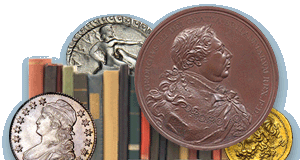
|
